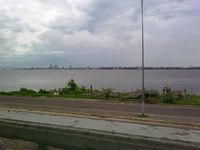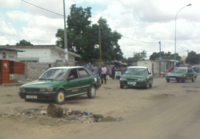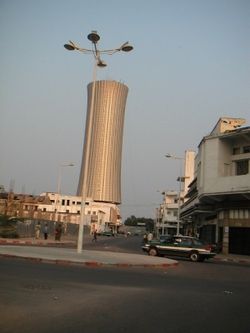Brazzaville
|
||||||||||||||||||||||||||||||

Brazzaville district
|
||||||||||||||||||||||||||||||

Brazzaville is the capital and largest city of the Republic of the Congo and is located on the Congo River. As of the 2001 census, it has a population of 1,018,541 in the city proper, and about 1.5 million in total when including the suburbs located in the Pool Region.[1] The populous city of Kinshasa (more than 10 million inhabitants in 2009),[2] capital of the Democratic Republic of the Congo, lies just across the Congo River from Brazzaville. Together with Kinshasa, the combined conurbation of Kinshasa-Brazzaville has thus nearly 12 million inhabitants. Over a third of the population of the Republic of Congo lives in the capital, and it is home to 40% of non-agricultural employment. It is also a financial and administrative capital.
Contents |
Geography

In order to distinguish between the two African countries with "Congo" in their names, the Republic of the Congo is sometimes called Congo-Brazzaville, as opposed to Congo-Kinshasa (the Democratic Republic of the Congo, known from 1971 to 1997 as Zaire, the capital of which is Kinshasa). Kinshasa lies on the southern bank of the Congo, across from Brazzaville. This is the only place in the world where two national capital cities are situated on opposite banks of a river, within sight of each other.
While Kinshasa lies to the south, Brazzaville lies to the north of the Congo River. The city is 506 km (314 mi) inland from the Atlantic Ocean and south of the equator. The city is a commune that is separated from the other regions of the republic; it is surrounded by the Pool Region. Around the city is a large savanna. The town is relatively flat, and situated at an altitude of 317 metres (1,040 ft).
History
The city was founded on 10 September 1880 on the site of a Bateke village named Nkuna by a Franco-Italian explorer, Pierre Savorgnan de Brazza, after whom the city was named. The local leader, Makoko of the Téké signed a treaty of protection with de Brazza which subjugated his lands to the French Empire. The city was built four years later in order to become a competitor with Léopoldville (now Kinshasa) which was built by the Belgians on the other side of the river. The site was occupied from October 1880 until May 1882 by a small squad of troops led by Senegalese Sergeant Malamine Camara, who prevented the land from falling into Belgian hands.
French control over the area was made official by the Berlin Conference of 1884. The city became the capital first of the French Congo, and then of French Equatorial Africa, a federation of states which encompassed Gabon, the Central African Republic and Chad. In 1924, the Congo-Océan railway was brought into service which linked Brazzaville with the port of Pointe-Noire.
During World War II Brazzaville, and the rest of French Equatorial Africa, remained beyond the control of Vichy France. In 1944, Brazzaville hosted a meeting of the Free French forces and representatives of France's African colonies. The resulting Brazzaville Declaration was intended to redefine the relationship between France and its African colonies after the war.
Until the 1960s, the city was divided into European (the center of the city) and African sections (Poto-Poto, Bacongo, and Makélékélé). In 1980 it became a "commune" separated from the Pool Region and divided into seven "arrondissements": Makélékélé (1), Bacongo (2), Poto-Poto (3), Moungali (4), Ouenzé (5), Talangaï (6) and Mfilou (7).
The city has frequently been a staging ground for wars, including conflicts between rebel and government forces and between forces of the Republic of Congo, the Democratic Republic of the Congo, and Angola. It was also the scene of bloody civil wars throughout the 1990s which resulted in thousands of civilian deaths and which forced hundreds of thousands of refugees to flee the city.
Industry
Industries present in Brazzaville include: machine shops, textiles, tanning, and manufacturing. As a key port on the Congo River, the city takes deliveries of raw materials, such as: rubber, wood and agricultural products. From here they are generally sent onward to Pointe-Noire for export.
Buildings and institutions
Notable buildings in the city include St Anne's Basilica, built in 1949 by Roger Erell, and known for its green tiled roof; Erell also designed a house in the city for Charles de Gaulle. Other buildings include the Nabemba Tower and the Congressional Palace. Other features include the Marien Ngouabi Mausoleum, Brazzaville Zoo and the Poto-Poto School of Painting.
The World Health Organization Regional Office for Africa is based in Brazzaville on a vast campus at the Cité du Djoué.
Climate
Brazzaville, much like neighboring Kinshasa, features a tropical wet and dry climate. Its wet season, which runs from October-May, is longer than its dry season, which covers the remaining months. Brazzaville’s driest months, July and August, sees on average no significant precipitation. Since Brazzaville is south of the equator, its dry season begins at around its “winter” solstice, which is the month of June. The city experiences relatively constant temperatures throughout the course of the year.
| Climate data for Brazzaville | |||||||||||||
|---|---|---|---|---|---|---|---|---|---|---|---|---|---|
| Month | Jan | Feb | Mar | Apr | May | Jun | Jul | Aug | Sep | Oct | Nov | Dec | Year |
| Source: BBC Weather [3] | |||||||||||||
Transport

The city is home to Maya-Maya Airport and a railway station on the Congo-Ocean Railway. It is also an important river port, with ferries sailing to Kinshasa and to Bangui via Impfondo. The Livingstone Falls lie on the outskirts of the city, where the Djoué River meets the Congo, rendering river transport to the coast impossible, qualifying the railway as a portage railway.
Taxis are available on every street and are easily recognized, being painted with a green body and white top, and the fare for a short trip is CF700. About twenty percent of the vehicles in Brazzaville are taxis. There are also collective taxis that drive certain routes and charge CF150.
Walking is quite safe, even while carrying expensive equipment and money, and since Brazzaville is a relatively small "bastion of civilization" it is easy enough to get around on foot.
Rankings
In the Mercer (consulting firm) Quality of Living survey of 215 cities; Brazzaville is ranked 211 in 2009. This is just above Ndjamena in Chad; Bangui in Central African Republic and Baghdad in Iraq. The rank for 2008 was 213 and 214 in 2007.
Sister cities
References
- ↑ 1.0 1.1 (French) Republic of Congo, Centre National de la Statistique et des Etudes Economiques (CNSEE). "Répartition de la population par Départements et Communes en 1984 et projetée de 2000 à 2015". http://www.cnsee.org/Donnees/structurelle/Démographie/RepartPop.htm. Retrieved 2007-06-30.
- ↑ 2.0 2.1 (French) Website of Unité de Pilotage du Processus d'Elaboration et de mise œuvre de la Stratégie pour la Réduction de la Pauvreté (UPPE-SRP). "Monographie de la Ville de Kinshasa" (SWF). http://www.dsrp-rdc.org/documents/Monographies_Provinciales/Monographie%20de%20la%20Province%20de%20Kinshasa.swf. Retrieved 2007-01-19.
- ↑ "Average Conditions Brazzaville, Congo". BBC Weather. http://www.bbc.co.uk/weather/world/city_guides/results.shtml?tt=TT000140. Retrieved September 8, 2009.
- Chavannes, Charles de. (1929) “Le Sergent Sénégalais Malamine.” Annales de l’Académie des Sciences Coloniales, vol. 3:159-187.
- Petringa, Maria. (2006) Brazza, A Life for Africa (2006) ISBN 9781-4259-11980
- Tiepolo, M. (1996) "City Profile: Brazzaville" in Cities v. 13, pp. 117–124
- Brisset-Guibert, Hervé (2007) Brazzaville petit guide historique, in the site www.presidence.cg ("palais presidentiel")
External links
- BRAKIN, the fusion city of Brazzaville and Kinshasa, urban analysis seminar with vectorised maps of the agglomeration by TU Darmstadt, 2009
- Maria Petringa's 1997 biographical article on Savorgnan de Brazza, describing events leading to the founding of Brazzaville
- Brazzaville travel guide from Wikitravel
|
|||||||
|
||||||||
|
|||||

